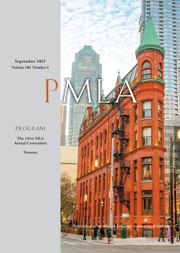No CrossRef data available.
Article contents
Abstract
An abstract is not available for this content so a preview has been provided. Please use the Get access link above for information on how to access this content.
Information
- Type
- Theories and Methodologies
- Information
- Copyright
- © 2025 The Author(s). Published by Cambridge University Press on behalf of Modern Language Association of America
References
Works Cited
Benjamin, Walter. The Correspondence of Walter Benjamin, 1910–1940. Edited by Gershom Scholem and Theodor W. Adorno, translated by Manfred R. Jacobson and Evelyn M. Jacobson, U of Chicago P, 1994.CrossRefGoogle Scholar
Du Bois, W. E. B.. The Souls of Black Folk. Edited by Brent Hayes Edwards, Oxford UP, 2008.Google Scholar
Ehrlich, Howard J. “Why the Black Flag?” Reinventing Anarchy, Again, edited by Ehrlich, AK Press, 1996, pp. 31–32.Google Scholar
Eichner, Carolyn J. “Civilization vs Solidarity: Louise Michel and the Kanaks.” Salvage, no. 4, 2017, salvage.zone/civilization-vs-solidarity-louise-michel-and-the-kanaks/.Google Scholar
Michel, Louise. The Red Virgin: Memoirs of Louise Michel. Edited and translated by Bullitt Lowry and Elizabeth Ellington Gunter, U of Alabama P, 1981.Google Scholar
Sexton, Jared. “All Black Everything.” E-flux Journal, no. 79, Feb. 2017, www.e-flux.com/journal/79/94158/.Google Scholar

